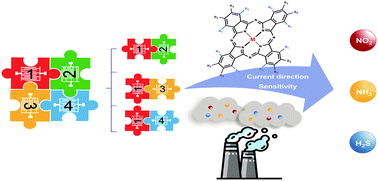A phthalocyanine sensor array based on sensitivity and current changes for highly sensitive identification of three toxic gases at ppb levels†
Abstract
A series of cobalt and metal-free phthalocyanine ambipolar semiconductors, MPc[β/α-O(4-CF3-Ph)4] (M = Co, 2H) (1–4), are synthesized and fabricated into self-assembled microstructures. The Co[Pc(β/α-OPhCF3)4] (1 and 3) molecules formed one-dimensional (1D) nanoribbons (400–300 nm) with a larger width of 1 relative to 3, whereas the H2Pc[β/α-O(4-CF3-Ph)4] (2 and 4) molecules self-assembled into wider microbelts (5–4 μm) with 2 larger than 4, showing the effect of the M center and the substituent positions of the Pc rings on the dimensions of the microstructures. An increased crystallinity is revealed in the order of 4 < 3 < 2 < 1, resulting in an increased conductivity in the same order. Towards NO2 and NH3, both positive and negative current changes are found among the sensors 1–4, with the lowest limit of detection (LOD) as low as 3 ppb for NO2 and 420 ppb for NH3 from 1, while a positive current response to H2S is obtained only from 1 with a LOD of 100 ppb, respectively, achieving the best results for the room-temperature detection of NO2, NH3 and H2S gases based on all of the solution-processed phthalocyanine-based sensors reported so far. Accordingly, the sensor responses are dominated by both M-analyst interaction (M = Co, 2H) and conductivity among the sensors 1–4. In particular, different sensor arrays consisting of the sensor of 1 combined with one of the other three sensors of 2–4 are established. NO2, NH3 and H2S gases at ppb levels can be accurately identified by the combination of two parameters, namely current change direction and sensitivity.



 Please wait while we load your content...
Please wait while we load your content...